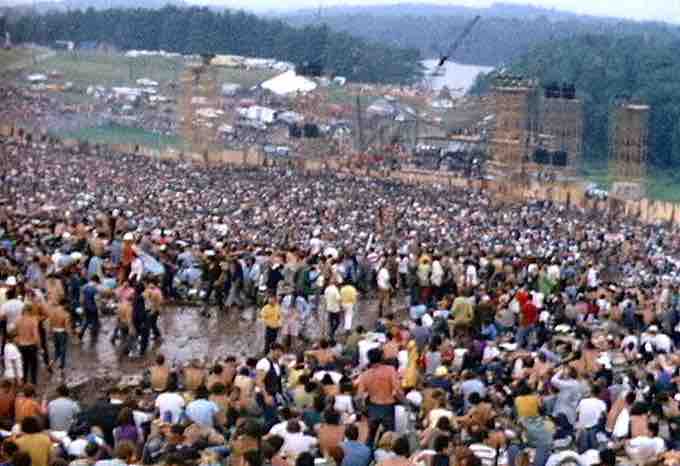Counterculture in Music
The music of the 1960s moved towards an electric, psychedelic version of rock, reflecting the off-beat, psychedelic characteristics of the counterculture itself. The Beach Boys' 1966 album Pet Sounds paved the way for later hippie acts, with Brian Wilson's writing interpreted as a "plea for love and understanding". Pet Sounds served as a major source of inspiration for other contemporary acts, most notably directly inspiring The Beatles' Sgt. Pepper's Lonely Hearts Club Band.
The Rise of Rock Music
Rock music is a genre of popular music that developed during the 1960s, particularly in the United Kingdom and the United States. It has its roots in 1940s and 1950s rock and roll. Rock music also drew strongly from other genres such as blues and folk, and was influenced by jazz, classical, and other musical sources. Like pop music, lyrics often stressed romantic love but also addressed a wide variety of social and political themes. Rock placed more emphasis on musicianship, live performance, and an ideology of authenticity than pop music.
By the late 1960s, a number of distinct rock music sub-genres emerged, including hybrids like blues rock, folk rock, country rock, and jazz-rock fusion. Other genres that emerged from this scene included progressive rock, which extended the artistic elements; glam rock, which highlighted showmanship and visual style; and the diverse and enduring major sub-genre of heavy metal, which emphasized volume, power, and speed.
The British Invasion
In 1964, the Beatles achieved a breakthrough to mainstream popularity in the United States. Their first appearance on the Ed Sullivan Show drew an estimated 73 million viewers (an all-time record for an American television program) and is often considered a milestone in American pop culture. They went on to become the biggest-selling rock band of all time. Over the next two years, British acts dominated both UK and US charts with Peter and Gordon, The Animals, Manfred Mann, Petula Clark, Freddie and the Dreamers, Herman's Hermits, The Rolling Stones, The Troggs, and Donovan all having one or more number one hit singles.
The Beatles themselves were influenced by many artists, among them American singer/songwriter Bob Dylan, who was a lyrical inspiration as well as their introduction to marijuana. Other folksingers like Joan Baez and Peter, Paul and Mary took the songs of the era to new audiences and public recognition. The Beatles went on to become the most prominent commercial exponents of the "psychedelic revolution" in the late 1960s.
U.S. Bands
Meanwhile in the United States, bands that exemplified the counterculture were becoming mainstream commercial successes. These included The Mamas & the Papas (If You Can Believe Your Eyes and Ears), Big Brother and the Holding Company (Cheap Thrills), Jimi Hendrix (Are You Experienced?), Jefferson Airplane (Surrealistic Pillow), The Doors, and Sly and the Family Stone (Stand!). Other bands and musicians, such as The Grateful Dead, Phil Ochs, Quicksilver Messenger Service, Melanie, Frank Zappa, Santana, and the Blues Project did not achieve such commercial success but are nevertheless considered key to the counterculture movement.
While the hippie music scene was born in California, an edgier scene emerged in New York City that put more emphasis on avant-garde and art music. Bands such as The Velvet Underground came out of this underground music scene and were predominantly centered at artist Andy Warhol's legendary Factory. The Velvet Underground supplied the music for the Exploding Plastic Inevitable, a series of multi-media events staged by Warhol and his collaborators in 1966 and 1967. The Velvet Underground's lyrics were considered risque for the era because they discussed sexual fetishism, transgender identities, and the use of drugs.
The 1960s also saw the rise in protest songs, with Phil Ochs's "I Ain't Marching Anymore" and Country Joe and the Fish's "I-Feel-Like-I'm-Fixin'-to-Die-Rag" among the many anti-war anthems that were important to the era.
Music Festivals
The 1960s was an era of rock festivals, which played an important role in spreading the counterculture across America. The Monterey Pop Festival, which launched Janis Joplin and Jimi Hendrix's careers, was one of the first of these. This festival was held in 1967 and had an estimated 55,000 to 90,000 attendees. The Monterey Pop Festival embodied the themes of California as a focal point for the counterculture and is generally regarded as the start of the "summer of love". This festival became the template for future festivals, most notably Woodstock.

Woodstock
The crowd and stage at Woodstock, one of the most important music festivals of the 1960s counterculture.
In August 1969, the Woodstock Festival was held in Bethel, New York and quickly became a symbol of the hippie movement. During this festival, 32 rock acts performed outdoors in front of 500,000 people. It is widely regarded as a pivotal moment in popular music history and has been regarded as a cultural touchstone of the 1960s.
Counterculture in Art
As with film, press, and music, art in the 1960s responded to the new counterculture, primarily in pop art and psychedelic art. For example, pop art challenged traditional fine art by including imagery from popular culture, such as advertising and news. The concept of pop art refers as much to the art itself as to the attitudes that it led to, and Andy Warhol is often considered representative of this type of art.
Psychedelic art also emerged in response to the counterculture and is defined as any kind of visual artwork inspired by psychedelic experiences induced by drugs, such as LSD. During the 1960s, psychedelic visual arts were often a counterpart to psychedelic rock music. This psychedelic art also represented the revolutionary political, social, and spiritual sentiments that were derived from these drug-induced, psychedelic states of consciousness.